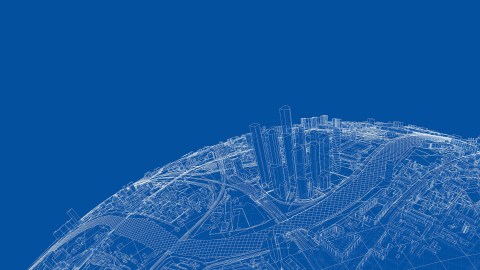Radical idea: Redraw the U.S. map as a nation of city-states

Credit: cherezoff / Adobe Stock
- The modern U.S. economy is really made up of metropolitan regions, not states whose boundaries are arbitrary compared to local economies.
- Today, states have an anti-urban bias due to their excessive political influence.
- One radical idea is to redraw the map as a nation of 55 city-states that reflect America’s real economic relationships.
Some blue-sky thinkers are questioning the relationship of cities and existing political boundaries. The modern U.S. economy is really made up of metropolitan regions, not states whose boundaries are arbitrary compared to local economies. A 2009 study identified eleven “megaregions” in the United States with 31 percent of all U.S. counties but 74 percent of the nation’s population and an estimated 80 percent of employment growth by the year 2025. Others have called for a restoration of cities’ annexing powers or greater metropolitan consolidation; reducing suburbs’ power over zoning, housing, and de facto segregated school systems; and limiting poor urban residents’ access to suburban-based jobs.
But perhaps the most radical idea would replace states with city-states — political regions centered on the real economy of cities and metropolitan areas. This would align regional economies with political boundaries and eliminate states’ anti-urban bias and their excessive political influence. A 2016 economic geography analysis sorted the lower forty-eight states into fifty-five economically based regions, each centered on a region’s major city and commuting patterns. The map effectively outlines a nation of city-states reflecting America’s real economic relationships instead of the noneconomic jurisdictions of counties and states, which favor rural and suburban political power over cities.
Redrawing America into city-states also could lessen the power of suburbs or encourage them to be more cooperative. It would allow better delivery of public services but also lead to more equal sharing of regional economic costs. Simply engaging in this admittedly impractical thought experiment reveals the deep spatial misalignment of America’s economics and politics. While cities drive regional and national economic growth, innovation, and prosperity, their political geography means they cannot effectively deal with inequality, poverty, and other social and economic problems.
State restrictions on city autonomy often preempt city policies that promote equity. Can long-standing state hostility to cities be reversed, turning states toward more progressive directions? Drawing on lessons from Los Angeles and elsewhere, economist Manuel Pastor points to progressive labor, immigration, climate, and voting policies in California that are driven by “intersectional movements” with a long-term “coherent economic vision.” Pastor is hopeful, saying that “California is America, only sooner.” In New York and New Jersey, unified Democratic control of state governorships and legislatures, rooted in urban votes, has led to more aggressive action on climate, labor, and tenants’ rights, although initially doing little on housing construction or equitable economic development.
But other states lag far behind, retaining their anti-urban bias. The so-called Texas Triangle, bounded by Dallas–Fort Worth, Austin–San Antonio, and Houston, produces over 75 percent of the state’s GDP and has over 65 percent of the state’s population, but it lacks proportionate political power. Given America’s history and political infrastructure that puts cities at a disadvantage, federal housing and transportation policies that continue shaping the nation’s urban form in favor of sprawl and sub-urbanization, state political control over cities, and the ever-continuing damage caused by racial segregation and conflict, local steps ultimately will not be enough.
Although voting patterns suggest suburbs in large metros can sometimes align with central cities, that cooperation historically has never included revenue sharing, school desegregation, or widespread housing integration. Some states pursued extensive legislative redistricting after the 2020 census, further weakening city and suburban minority populations by diluting their votes. Using a technique known as “cracking” — splitting city populations into separate districts — Tennessee is allocating Nashville’s population across three separate congressional districts, all of which observers expect to be won by Republicans.
There is little prospect of addressing inequality through market economists’ prescription of fostering tax and regulatory competition among cities, coupled with their deep skepticism and reluctance to try new public interventions. Economists correctly identify cities as the sources of innovation and economic growth. The big data analyses of economist Raj Chetty and his colleagues underline the paradox that dense metropolitan areas have higher per capita GDP but often lower intergenerational upward mobility. A decades-long failure to build housing has driven homeownership and rental costs to historic highs. The lack of intergenerational mobility and lost wage premiums for cities are evidence of, and major contributors to, rising urban inequality.
Economists also have documented declining urban wage premiums for less-educated adults, linked to a “hollowing out of middle-skill, non-college, blue-collar production and white-collar administrative support jobs.” The growth in lower-paid jobs has characterized urban job markets for some time, and it is documented by economist David Howell in his work on the expansion of “lousy jobs” after 1979. Howell criticizes economists’ attachment to skill-based explanations of declining wages and job quality, saying that it ignores “the need to rebalance bargaining power between employers and workers.” These lower-paid jobs have been slowest to come back in urban labor markets due to COVID-19, leading to high city unemployment rates, especially for minority and less-educated workers.
Economist Edward Glaeser agrees that “lower urban opportunity remains a major problem for American cities,” but he suggests the pathway is changing educational systems and providing human capital, which is consistent with a focus on individual skills. In this view, reform is inhibited by “insiders” such as teachers’ unions, wealthy homeowners fighting new housing construction, overregulation of business start-ups, and occupational licensing. These insiders capture city political and policy processes to the long-term detriment of growth.
Institutionalist economists have in turn documented economic stagnation and declining opportunity as driven by changes in private economic power, which is enabled by public policy favoring businesses and higher-income households. Local efforts to change political and economic power, including new or expanded roles for government and collective action, are essential for greater urban equity. But those local movements must have concrete visions of equitable economic growth along with housing and infrastructure development, not just redistribution. Economists can help by including historic and institutional factors and analysis of power relationships to help explain and devise equity policies.
Ultimately, resolving America’s urban inequality — which also would boost the entire economy — will require national policy changes aligning cities’ central economic role with new political arrangements that can foster shared prosperity. Cities need a stronger governing role in their metropolitan areas to help bring the regional economy and governance into alignment with each other and thus allow more aggressive enforcement of racial and social equity in housing, economic development, labor rights, and education. Cities also should have more representation in their state governments, to accurately reflect the importance of their economic roles.





